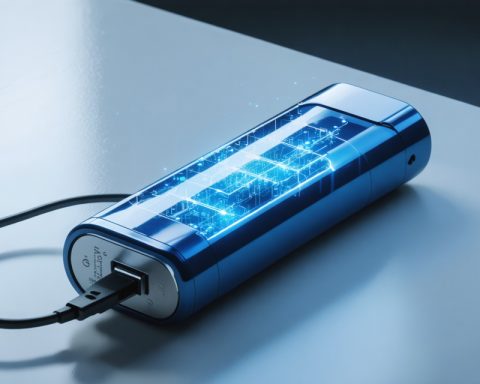- Aqueous redox flow batteries utilize water-based solutions, offering a sustainable and long-lasting alternative to lithium-ion batteries.
- These batteries are environmentally friendlier and safer due to non-flammable electrolytes, supporting numerous renewable energy applications.
- Modular designs allow scalability, making them cost-effective for powering anything from homes to entire communities.
- Countries like China are already implementing large-scale flow battery systems, with ongoing research to improve affordability and durability.
- Flow batteries can complement hydropower by providing resilient solutions against climate-induced energy challenges.
- This technology is crucial for achieving carbon-neutral goals by 2050, aligning with electric vehicle infrastructure needs.
- Eco-conscious consumers can participate in the green shift by adopting energy-efficient technologies like heat pumps, reducing expenses and emissions.
- Innovative power storage solutions are advancing, promising a sustainable future powered by the natural element of water.
A new chapter in sustainable energy is unfolding with the hum of pumps and the rush of water in scientific labs and renewable energy facilities worldwide. At the forefront of this change is the promising technology of aqueous redox flow batteries, which employs nature’s most abundant resource—water—to power the grids of tomorrow.
Picture a dance of molecules, fleeting yet harmonious, within sprawling battery systems that rely on H2O-based solutions. These setups, meticulously crafted with a network of pumps and pipes, channel fluids through an electrochemical cell. In this delicate dance, energy is not just harnessed—it’s tamed, stored, and ready to be unleashed upon demand.
These water-based flow batteries are not only long-lasting—enduring over two decades—but also environmentally friendlier and safer than their lithium-ion predecessors. Due to the non-flammable nature of water-based electrolytes, such innovations offer peace of mind with promising potential. Their modular design allows scalability, and they pose as a cost-effective and sustainable contender in the global energy feedback loop. They could power a home, a village, or an entire community.
Countries like China have already realized part of this potential, operationalizing massive flow battery systems that energize tens of thousands of homes for hours on end. Meanwhile, engineers in the UK and other global hubs are doubling down on research to overcome present challenges, such as sourcing affordable and durable materials for these batteries.
Water has always been a hero in Canada’s energy narrative, contributing significantly to the national grid, particularly amidst the shifting backdrop of climate change. Yet, the impact of unpredictable weather patterns—marked by lower precipitation and rising temperatures—underscores the need for adaptable solutions. Enter the era of flow batteries that might serve as a resilient companion to pump storage hydropower frameworks, amplifying the return on renewable efforts.
For Canada and the world, mastering this technology signals hope for carbon-neutral ambitions by 2050. The alignment of aqueous flow packs with electric vehicle charging infrastructures offers a glimpse into a pristine, emissions-free horizon. These advancements align with the global mandate to curb warming, which experts like NASA have connected to intensifying weather extremes.
For eco-conscious consumers, embracing the green shift starts closer to home. Transitioning to energy-efficient heat pumps can slice thousands off lifetime heating bills and qualify for tempting tax breaks. As clean energy solutions evolve, so too does our role in the energy ecosystem.
Stay informed about how these strides in technology could reshape the planet’s energy landscape. A future brimming with innovative power storage is on the horizon, where the whispering of water holds the key to a sustainable tomorrow.
Spark Innovation in Energy with the Breakthrough of Aqueous Redox Flow Batteries
Understanding Aqueous Redox Flow Batteries
Aqueous redox flow batteries are emerging as a game-changer in sustainable energy. Utilizing water-based solutions, these batteries offer a safer and more environmentally friendly alternative to traditional lithium-ion counterparts. The principle behind these systems involves the circulation of aqueous electrolytes through electrochemical cells, effectively storing and releasing energy as needed.
Advantages and Real-World Applications
1. Longevity and Safety:
Flow batteries boast a lifespan of over 20 years, thanks to their robust design and the non-flammable nature of water-based electrolytes. This makes them a safer choice, reducing the risk of fires and other hazards commonly associated with lithium batteries.
2. Scalability and Modularity:
The modular nature of flow batteries allows them to be easily scaled to meet varying energy needs. Whether it’s powering a single home or an entire community, these setups can be adjusted to fit the required capacity, making them a versatile addition to the energy grid.
3. Environmental Impact:
Given their reliance on water, aqueous redox flow batteries offer minimal environmental footprint compared to other energy storage technologies. Their adoption can significantly reduce carbon emissions, aligning with global carbon-neutral targets aimed for 2050.
4. Integration with Renewable Systems:
Countries like China have already deployed massive flow battery systems capable of powering tens of thousands of homes. In conjunction with renewable sources like solar and wind, these systems provide reliable energy, even amidst fluctuations in renewable outputs.
How-To Steps and Life Hacks for Implementation
Step 1: Assess your energy requirements and determine the potential need for scalable battery solutions.
Step 2: Consult with energy experts or firms specializing in flow battery technology to explore options and installation specifics.
Step 3: Explore government incentives or rebates for introducing clean energy technologies to offset initial costs.
Step 4: Consider the long-term savings on energy bills and reduced carbon footprint as part of the decision-making process.
Market Forecasts and Industry Trends
The global energy storage market is continually evolving, with an increasing focus on sustainable and renewable technologies. As per industry analyses, the demand for flow batteries is projected to grow substantially, driven by the need for efficient and sustainable energy solutions. Their ability to complement other renewable energies makes them a critical component of future energy strategies worldwide.
Pros and Cons Overview
Pros:
– Long lifespan and low operational costs.
– Environmentally friendly and safe.
– High scalability and adaptability to various energy needs.
– Compatible with renewable energy sources.
Cons:
– Initial cost can be significant, although offset by long-term benefits.
– Sourcing of affordable and high-durability materials remains a challenge.
– Technology is still evolving, with ongoing research needed to fully optimize performance.
Actionable Recommendations
– Stay Informed: Keep abreast of the latest advancements in aqueous redox flow technology to capitalize on emerging trends.
– Explore Incentives: Look into available incentives for transitioning to sustainable energy technologies to minimize costs.
– Evaluate Energy Needs: Regularly assess your energy consumption patterns to identify opportunities for integrating flow batteries into your energy solutions.
– Consider Collaboration: Engage with local energy providers to explore collaborative opportunities in adopting flow battery technologies within your community.
Final Thoughts
Embracing technologies like aqueous redox flow batteries is vital for a sustainable future. By understanding their benefits and challenges, and how they integrate with existing systems, individuals and communities can make informed decisions towards a cleaner energy future. As advancements continue and markets expand, these batteries will likely play a pivotal role in reshaping the global energy landscape.
For more on sustainability and renewable energy, visit National Geographic for insights and updates.

















